Visiting Salzburg Fortress Hohensalzburg: What to Do Inside
Salzburg is hands down one of my all-time favorite European cities! It’s simply bursting with beautiful characteristics — from its baroque architecture to its alpine natural beauty, its world-famous musical heritage, fascinating culture, and rich history.
And the best part? You don’t even have to leave the city limits to experience it all! Right in the heart of Salzburg sits the magnificent Hohensalzburg Fortress, a place that truly offers it all. Later, you’ll see! 🙂 Thus, Hohensalzburg Fortress is a must-see when having a Salzburg trip.
I’ve got you covered with everything you need to know to make the most of your visit to Hohensalzburg Fortress. From things to do, to how much time you’ll need, visiting information, tips, and more.

This post may contain affiliate links. I may receive a tiny commission at no additional cost to you from any qualifying purchases using the link.
I’m a huge fan of fantasy novel movies and I have a strong desire to see places that look like them, such as mountains, villages, old towns, and castles.
When I go to these places, I feel more than just a traveler.
I feel like I’m traveling through time to a more meaningful era; a way to escape from this modern world where money seems to be the only thing that matters.



Note: This is a comprehensive post about Hohensalzburg Fortress. Remember, you can use the table of contents to quickly jump to different parts of the article you want to read first. However, you can click here to immediately go to the list of things to do in Hohensalzburg Fortress.
Introduction to Hohensalzburg Fortress
Visiting Hohensalzburg Fortress, that’s what you may also feel—to be transported back in time.



But I gotta say, when I was exploring the fortress, it didn’t completely feel as authentic as I thought it would.
Some of the rooms have been turned into museums with a modern design, so it’s not exactly what I was expecting.
However, even though the fortress isn’t used for its original purpose anymore and doesn’t look totally medieval, you can still totally feel like you’ve gone back in time when you’re there!
The prettiest parts of the fortress are preserved, and there’s a ton of stuff that’s super old and gives you a peek into the past…
The feeling like you’ve gone back in time is just one of the cool things about visiting Hohensalzburg Fortress, though.
There’s so much more that makes it worth spending time there!

Save to Pinterest

I’ll show more of them to you as we go along…
Need an idea how to visit Salzburg? Check my post(s):
Old Town Salzburg Walking Tour Map (Highlights & Viewpoints)
17 Free Things to Do in Salzburg: One Day Budget Itinerary
Two Days in Salzburg Itinerary: Old Town and a Day Trip
Three Days in Salzburg Itinerary: Complete And Laid Back
Links open in a new tab.
Where Is Hohensalzburg Fortress?
Among the landmarks and tourist attractions in Salzburg, there is none easier to find than Hohensalzburg Fortress.


Discover — Kapuzinerberg: Best Views of Old Town Salzburg

This huge medieval fortress sits atop Festungsberg, a hill in the heart of the city.
Perched 506 meters high, Hohensalzburg Fortress dominates the skyline of Salzburg.
You should be able to spot Hohensalzburg Fortress right away from nearly every part of the city with wide open spaces, especially from parks, bridges, and walkways along the Salzach River.
From anywhere in Old Town Salzburg, it would take less than a 20-minute walk to reach Festungsbahn, the funicular station that conveniently brings tourists to Hohensalzburg Fortress.


You might like to discover Hohensalzburg fortress’ sister — 5 Reasons To Visit Hohenwerfen Fortress in Salzburg. It’s one of the most beautiful fortresses in Europe.

(I’ll explain to you the details of getting to Hohensalzburg Fortress later under the visiting information section)
Hohensalzburg Brief History
Sometimes, visitors forget to take a few minutes to learn about where they’re going. When they do, they often discover even more reasons to be excited about their visit.
To make your visit to Hohensalzburg Fortress more interesting, I’ll help you learn about the history and interesting features of Hohensalzburg Fortress.



By knowing the history of Hohensalzburg Fortress, you’ll also get an idea of how far back in time you’ll be transported to during your tour of the fortress.
While Hohensalzburg Fortress has been a major tourist attraction in Salzburg since the late nineteenth century, its history goes back to the start of the high medieval ages…
The story of Hohensalzburg begins in 1077, when Archbishop Gebhard von Helfenstein built a basic fortress with a wooden wall.
Over the centuries, many changes and improvements were made to the fortress. In 1462, Prince-Archbishop Burkhard II von Weißpriach added ring walls and towers.
Later, in the late 15th and early 16th centuries, Prince-Archbishop Leonhard von Keutschach expanded the fortress even more.
He created the St. George’s Chapel and the Royal Apartments including Golden Hall, the Golden Chamber and the Sleeping Chamber.
In the 16th and 17th centuries, external bastions were added to protect against Turkish invasion.
During the Thirty Years’ War, Archbishop Count Paris of Lodron made the fortress even stronger by adding gunpowder stores and additional gatehouses.
However, in 1800, during the Napoleonic War of the Second Coalition, the fortress was surrendered to French troops without a fight.
After that, it was used as a barrack, storage depot and dungeon before being abandoned as a military outpost in 1861.
With the opening of Festungsbahn funicular railway in 1892, it gained its new purpose: a tourist destination.
Hohensalzburg Fortress Fascinating Facts
Today, Hohensalzburg Fortress is one of the best-preserved and largest medieval castles in Europe, making it a notable place for people to visit.
Based on what I have discovered about Hohensalzburg Fortress, I find it to be a truly impressive medieval structure.


Discover: Mirabell Palace In Salzburg: 5 Reasons Why You Must Visit

Hohensalzburg Fortress possesses advanced features for its time of construction, contains fascinating stories within its parts, and boasts areas that are absolutely a must-see.
Below is the list of facts about Hohensalzburg Fortress that makes it more interesting to visit.
Maximize your Salzburg adventure by checking out these Salzburg Travel Inspiration posts. They’ll help you find the perfect experiences to suit your preferences
5 Beautiful Day Trips From Salzburg (Nearest Destinations)
10 Unique Things to Do in Salzburg, Austria
The Beauty of Salzburg: 7 Beautiful Things to See
5 Spots In Salzburg to see Sunset or Sunrise (With a Map)
20 Sights and Landmarks in Salzburg: History & Architecture
Click to open in a new tab.
Fact no. 1: Function of Hohensalzburg Fortress
Did you know that the Prince-Archbishops, who ruled over Salzburg for a very long time, used to live in their residence in the city?
However, the residence of the Prince-Archbishops was not sufficiently fortified to provide protection during turbulent times.
In such situations, they would move to Hohensalzburg Fortress for refuge.
As the safe haven of the Prince-Archbishops, Hohensalzburg was constantly updated with the most recent developments in assault weapons and fortifications to ensure their safety.
Fact no. 2: Hohensalzburg From Salt
Did you know that the salt trade was a key source of income for Salzburg and the Prince Archbishops?
The Archbishops of Salzburg amassed great wealth and power through the production and export of salt from Duerrenberg.
It was a lucrative trade that enabled them to undertake grand projects such as the construction and expansion of the Hohensalzburg Fortress.
You can learn more about it during the first portion of the Panoramatour of Hohensalzburg Fortress.
Fact no. 3: The Granary of Hohensalzburg Fortress
Did you know that one of the oldest preserved buildings in the Hohensalzburg Fortress is the granary, built in 1484?
It is also called “Schüttkasten” in German (meaning, “pour warehouse”) for the unique method of storing the grains: not in sacks, but poured directly onto the wooden floors.
Impressively, this structure was capable of storing enough grain to feed up to 300 people for an entire year. Yes, that’s 365 days!
Fact no. 4: Gigantic Cistern of Hohensalzburg Fortress
Did you know that Hohensalzburg Castle boasts a gigantic underground cistern, built in 1525?
The archbishop even had architects brought from Veneto to construct this enormous cistern which measures 17 x 17 x 7.2 meters and could hold up to 340,000 liters of water.
Gutter pipes collected the water from the surrounding roof area, while underground wooden pipes transported it to a stone basin filled with clean gravel.
This ingenious construction allowed rainwater to be collected and filtered, making it usable for both humans and animals for centuries.
Fact no. 5: Hohensalzburg’s Goods Lift
Did you know that Hohensalzburg Fortress has a goods lift, and it is likely the oldest of its kind in the world?
This 180-meter-long cable railway on the eastern side of the mountain on which the fortress stands is believed to be the oldest operating funicular railway in Europe.
Its origins date back to before the reign of Archbishop Leonhard von Keutschach (1495-1519).
Fascinatingly, prisoners operated Hohensalzburg Fortress’ goods lift with horses during its early days.
Fact no. 6: The Bull of Salzburg
Did you know that the Kuenburg bastion of Hohensalzburg Fortress, originally built to make room for large guns and cannons, houses the “Bull of Salzburg?”
“The Bull of Salzburg” (German: “Salzburger Stier”) is located on the dovecote of the bastion and has been there since 1640.
But is it an animal? Of course not!
Rather, it’s a mechanical organ with 138 metal pipes, windchest, and bellows. This impressive instrument sends an F major triad twice daily over the city of Salzburg, awakening the people in the morning and announcing the end of the workday.
Even today, the “Salzburger Stier” still “roars” daily at 7:05 am, 12:05 pm, and 6:05 pm.”
Fact no. 7: Archbishop Keutshach and the Royal Apartments
Did you know that Archbishop Leonhard von Keutschach was responsible for creating the richly furnished rooms of Hohensalzburg Fortress?
These rooms, known as the “royal apartments,” include three representational rooms: the Golden Hall, the Golden Chamber, and the Bedroom Chamber.
Today, these rooms are the architectural highlight of any visit to Hohensalzburg Fortress and are not to be missed.
While Hohensalzburg was mainly used as a refuge, the fortress also served as a place to impress other rulers visiting the city back in the day
When visiting the fortress, make sure to check out these luxurious rooms and imagine what it would have been like to live like royalty in medieval times.
Fact no. 8: Golden Hall Concerts
Did you know that the Golden Hall in Hohensalzburg Fortress was the place where Prince Archbishops held different events?
Even today, events are still held in this magnificent hall, such as Mozart concerts.
You can check the official website of Hohensalzburg Fortress (linked at the resources section) for the schedule of these events and experience the grandeur of this historic hall for yourself.
Attending concerts in this awe-inspiring room with its Gothic portals, columns, and azure coffered ceiling is indeed an opportunity for a memorable moment in Salzburg.
Discover Mozart’s Birthplace: Interesting Things To Discover Inside.
Fact no. 9: Insightful Details of the Golden Hall
Did you know that the 17-meter-long beam in the Golden Hall of Hohensalzburg Fortress tells a story about the history of Salzburg?
The beam is painted with the coat of arms of both Archbishop Leonhard von Keutschach and the empire, as well as those from the most powerful German cities and dioceses allied with Salzburg.
The Golden Hall itself is one of the most spectacular rooms in the fortress.
I marvel at its blue wooden ceiling adorned with golden joists and buttons that resemble a star-filled night sky.
Fact no. 10: Hohensalzburg Funicular
Did you know that the Salzburg funicular railway to Hohensalzburg is the oldest of its kind in Europe?
In 1892, Salzburg Rail & Tramway Inc. opened the Salzburg funicular railway in response to the growing tourism industry.
Originally known as the Tröpferlbahn, the railway was powered by water.
Since its opening, the fortress railway has transported approximately 77 million passengers.
Things To Do In Fortress Hohensalzburg
After learning about Hohensalzburg Fortress, you may already have an idea of the fascinating discoveries and breathtaking experiences that await you.
However, these are just the tip of the iceberg. In this part, you’ll see that Hohensalzburg Fortress has many points of interest and offers interesting experiences to try.



In addition to admiring the historical and stunning parts of the fortress, Hohensalzburg Fortress offers breathtaking views of the city and the Alps.
There are viewpoints (bastions, courtyards, and restaurants) where you can take a break and relax.
Inside the fortress, there are also museums and several exhibitions to explore. If you’re interested in learning something new, there’s plenty to discover.
If you time your visit to Hohensalzburg Fortress just right, you might even be able to attend a concert in the fortress’ most beautiful room.
After the list of things to do in Hohensalzburg Fortress, you’ll see more pictures to spark your wanderlust!
1. Princely Chambers & Magic Theater
If you’re like me and enjoy marveling at old-world architecture, the Princely Chambers should be at the top of your list when visiting Hohensalzburg Fortress.
The Princely Chambers are an architectural highlight of the fortress, boasting a unique secular Gothic-style that is among the best-preserved in Europe.



However, did you know that you can see more than 3 parts of Hohensalzburg Fortress in Princely Chambers?
In addition to the Golden Hall, Golden Chamber, and Bedchamber, there’s also a toilet (or “garderobe” as they call it) that’s surprisingly simple for a prince archbishop.
And there’s a library too, connected to the Golden Chamber by a narrow wooden doorway.
Sadly, we can’t know what books, maps, and letters Archbishop Keutschach may have studied there since the library inventory has been lost over time.
It’s in the Princely Chambers that we can find the cute Magic Theater. This lovely presentation is a lovely bonus, bringing the fortress’ history to life with film and animated props.
And don’t worry, there’s an English translation for the audio, so you won’t miss a thing!
Golden Hall
The first stop on our tour of the Princely Chambers is the magnificent Golden Hall.
This grand space was once the site of many a festive gathering and social event, hosted by the Prince Archbishop himself.

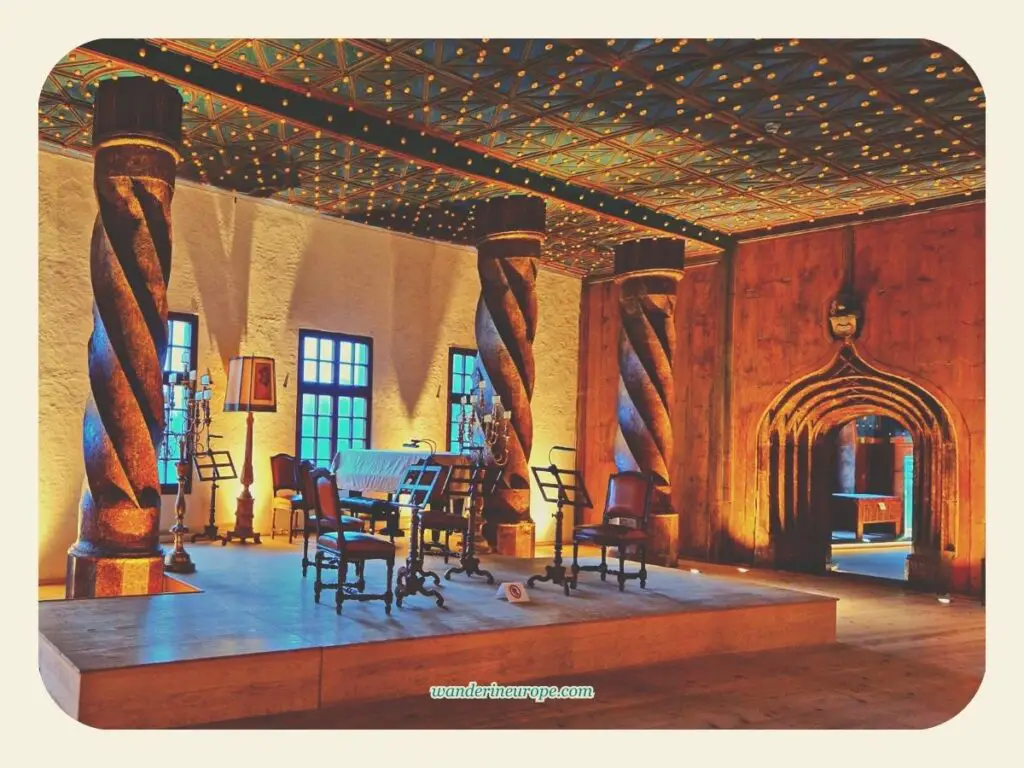

And with its size and splendor, it’s easy to imagine elegant balls taking place here.
Fascinatingly, even today, the Golden Hall continues to serve as an event space, hosting musical performances such as Mozart Concerts in the evenings.
But what really caught my eye as I explored the hall was the stunning ceiling, supported by four mighty twisted marble columns.
Its starry-sky-like appearance is truly unique among medieval ceilings!
Looking for a historical discovery? Don’t forget to check out the coats of arms adorning the beam and walls, representing the kingdom, powerful German cities, and bishoprics affiliated with Salzburg.
Be sure to take a peek at the coat of arms above the marble portals too!
Golden Chamber
The Golden Chamber is the most decorated of all the Princely Chambers.
It’s filled with beautiful details, like the golden vines above the doorways, the library door that looks like it’s straight out of Narnia, and the coats of arms above the windows.



Indeed, the Golden Chamber is a stunning room, and it would have been even more amazing if the cloth and leather on the walls had survived over time.
As you explore, you’ll see just how much influence Prince-Archbishop Leonhard von Keutschach had as both a ruler and a religious leader.
One of the things that makes the Golden Chamber extra special is the big, colorful stove by the door. You’ll notice it right away when you walk in.
It’s a rare and valuable example of Late Gothic ceramic art, with a mix of Gothic and Renaissance styles.
The top of the stove looks like a colorful cathedral, but it’s the bottom part that really stands out.
It has four rows of tiles decorated with flowers and fruits from the new world, discovered by European explorers in the 15th century. It’s definitely something unique to see.
Bedchamber
Like the Golden Hall, the Bedchamber is another room in Hohensalzburg Fortress with beautiful decorations.



The top part of the walls has gold buttons and rosettes, while the bottom part, which isn’t decorated much now, was probably once covered in leather or velvet.
There isn’t any furniture left in the room, but you can still see the fancy woodwork on the walls that shows how grand the room used to be.
2. The Armory
As a tourist attraction from the medieval ages, Hohensalzburg Fortress offers a variety of discoveries, giving insights into what life was like back then.



It includes the different armors, guns, canons, weapons, and accessories that were used to defend the fortress from any enemies.
You can find them in the armor exhibition which was opened to the public in 2019.
While the place of exhibition has a modern design, the armors aren’t new to this spot in the castle.
The exhibition is located in the armory of Hohensalzburg Fortress which was originally the storage facility of the fortress.
Some of the items you’ll discover are platemails, full body armor, swords from 1350 onwards, and so on.
You can see projections behind the armors and weapons, letting you know how old they are and how they were used before.
There are also drawings depicting how the armors were used, stored, prepared, and cleaned.
3. The Panorama Tour
Are you ready for the most breathtaking views of the city and the Alps from Salzburg?
Then you have to check out the Panorama Tour at Hohensalzburg Fortress!

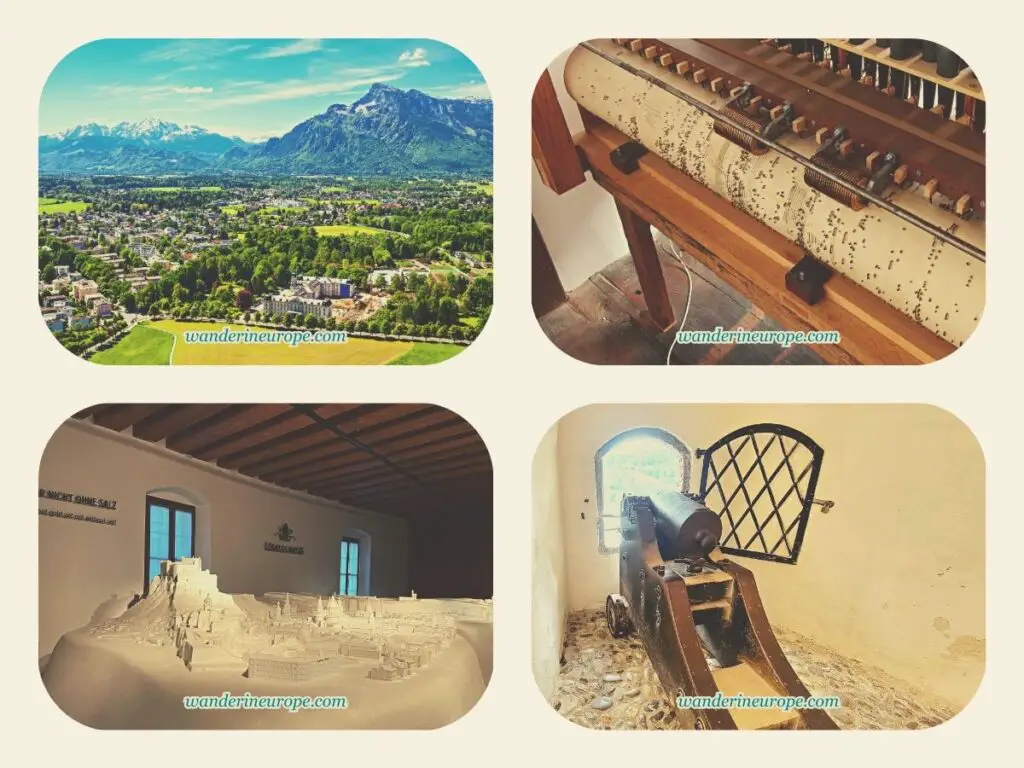

Like the Princely Chambers, it’s one of the highlights of visiting Hohensalzburg Fortress and I bet you’ll enjoy it, too, especially if you’re into panoramic views like me.
You know me, I’m always magnetized by mountains and breathtaking views!
In the Panorama Tour at Hohensalzburg Fortress, you can access 5 different areas of the fortress.
The Panorama Tour begins at the Salt Depot and takes you up to the Dungeon and Viewing Platform, before leading you down to the Salzburg Bull via the Battlement Walkway.
You’ll get to walk along the castle guard’s walkways and bastions of the fortress where all these scenic experiences await.
If you have a strong imagination, you’ll feel like a medieval guard yourself, surveying the surroundings for potential threats and enemies.
There will be a lot of walking and stairs, especially in the dungeons up to the viewpoint, so you have to wear comfortable footwear.
In addition to the panoramic views, there are several little nuggets of history that you can discover along the path of the Panorama Tour, which makes the walk even more interesting.
By the way, you can also find other panoramic vantage points of Old Town Salzburg or the Alps from Mönchsberg: 5 Things To Do on This Hill in Salzburg.
Salt Depot
The first stop on the Panorama Tour of Hohensalzburg Fortress is the Salt Depot.
As you might have guessed from its name, this is where the prince-archbishops of Salzburg used to store their precious ‘white gold’.

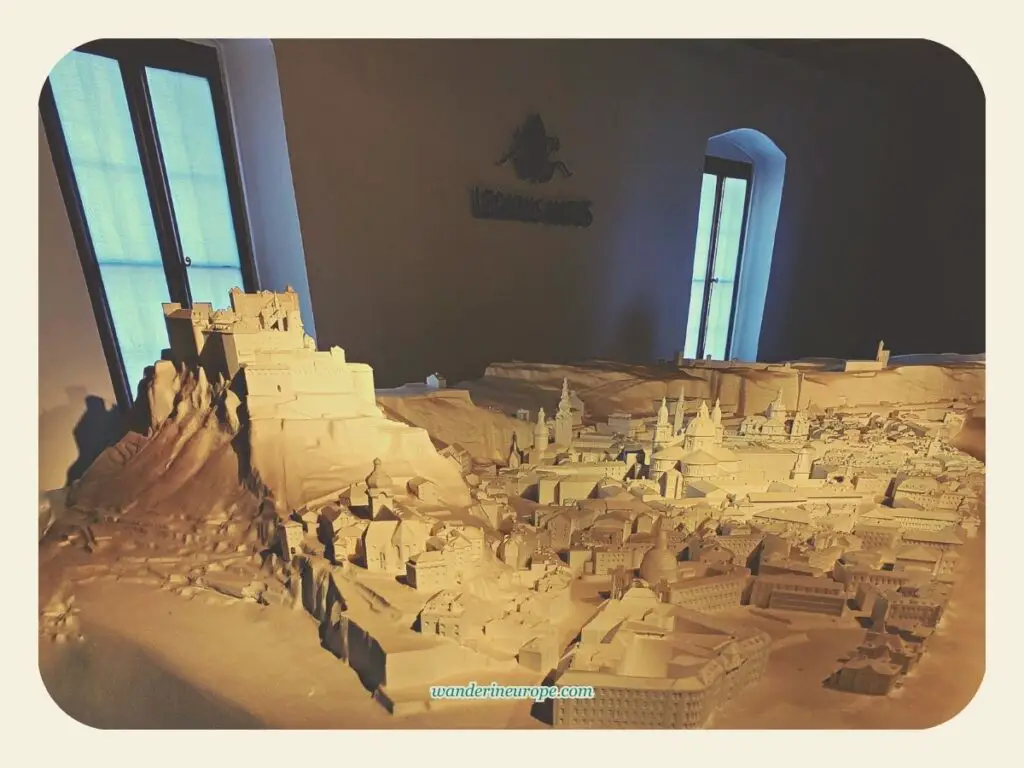

Interestingly, the Salt Depot still contains salt today.
It now features a detailed 3D model of the town made entirely of rock salt. This model provides a preview of the stunning views that await you from the fortress’s panoramic viewpoints.
Just by looking at the model, you’ll discover how Salzburg’s location helped it grow into a bustling cultural hub: Surrounded by mountains and built along a river at the crossroads of three major trade routes.
These routes connected Salzburg to Italy, Augsburg, and Linz, making it a thriving center of commerce and culture.
Aside from the geography of Salzburg from the Salt Depot, the room also gives insights about the city’s salt industry.
Dungeon
After exiting the Salt Depot, you’ll be led to the Hohensalzburg’s Dungeon.
It’s a simple prison that if you’ve been to other fortresses in Europe, you’ll find the dungeon of Hohensalzburg Fortress a little less cruel.

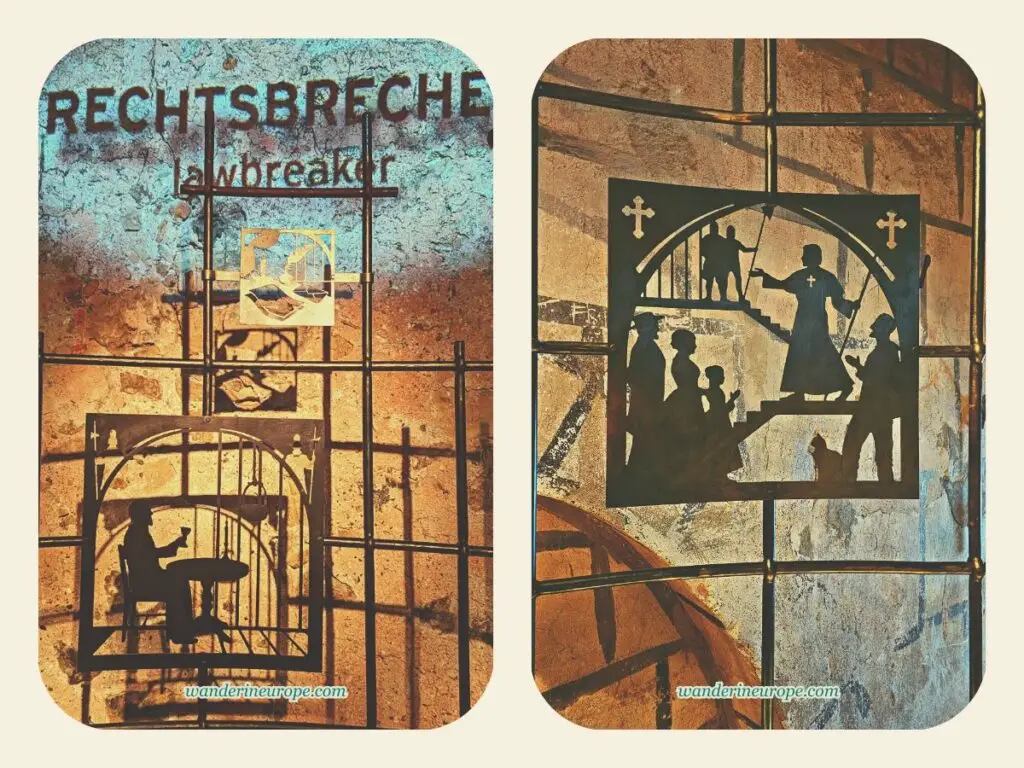

It’s because, based on the information board, Hohensalzburg Fortress was not the seat of the court.
Thus, there were no judges to conduct ‘painful questioning’ in a torture chamber and, indeed, Hohensalzburg Fortress did not become a the site of gruesome torture.
However, the fortress did have a dark dungeon in the Reckturm tower and prison cells, built around 1640.
While it later served as a prison for common criminals, in the 16th and 17th centuries, Hohensalzburg was mostly used for political purposes and to maintain state authority.
Those imprisoned within its walls included individuals with unwanted religious beliefs in predominantly Catholic Salzburg, leaders of riots, and those accused of treason.
Fascinatingly, an archbishop spent his final years as a prisoner of the fortress.
Viewing Platform
The dungeon features spiral stairs that lead to the viewing platform, which is the highlight of the Panorama Tour at Hohensalzburg Fortress.
After leaving the dungeon, you’re immediately greeted with a stunning 360-degree panorama of Salzburg, including the city, Salzach River, and the Alps.



It’s a breathtaking view; spectacular when it’s sunny.
The viewing platform has two levels, so don’t forget to climb a few steps to the upper level for an even better view.
After taking in the panoramic views, it’s time to head down to the Battlement Walkway. The entrance is located on the opposite side of the viewing platform where you entered.
As you make your way down the stairs, you’ll come across interesting stories about the fortress, written on pedestals that resemble small theaters.
Amazingly, these displays include visuals, some with mechanical controls, to help bring the stories to life.
The first small theater I saw tells about “The White Lady” of Hohensalzburg Fortress. It says:
The guards at Hohensalzburg were known for their bravery. However, on certain moonlit nights, they were overcome with fear.
They reported seeing a figure dressed in white robes, floating above the castle walls.
Whenever they tried to approach her, she vanished into thin air.
The appearance of the “White Lady” was considered an ominous sign, as misfortune often followed her sightings.
But there’s no need to worry if you see her today – it’s just a spooky tale from long ago.
Battlement Walkway
The Battlement Walkway, built way back in the latter half of the 16th century, is the 4th part of the Panorama Tour at Hohensalzburg Fortress.
This 400-meters-long walkway runs along the outer wall and encircles the entire fortress complex.



On the tour, you’ll be walking the section that connects the viewing platform to the Kuenburg Bastion, where you’ll find the Salzburg Bull.
During your visit to the walkway, there’s a few things to keep an out for.
Some of them are the small windows along the way — they were used by medieval guards to keep watch over the city and its surroundings.
Take a peek for some cool views of Salzburg and its outskirts!
There are information boxes and small theaters in front of some windows to keep you entertained as you stroll towards Kuenburg Bastion.
One of them is entitled, “The Fortress Fire Station.” And it tells:
Hohensalzburg Castle, with its overlooking view of Salzburg, played a vital role in the city’s firefighting efforts.
In the late 18th century, engineer Ludwig Grenier implemented an innovative system to improve fire detection and response.
He installed stone slabs in front of many windows along the castle’s walkway, each featuring key points of orientation such as city gates
Swiveling telescopes were also added, enabling fire guards to accurately determine the location of a fire, even during the night.
To communicate the location of the fire to city firefighters, each district had a unique signal that was transmitted using flags during daylight hours and lanterns at night.
This system proved to be highly effective and remained in use until 1925, long after the invention of the telephone.
Salzburg Bull
The Kuenburg Bastion is one of the most fascinating parts of Hohensalzburg Fortress because it houses the “Salzburg Bull,” which is a simple type of organ with over 100 pipes.



It has been used as an alarm clock for the city since the early 16th century, playing a sharp triad in F major over the city to wake people up at 4 am and signal that it’s bedtime at 7 pm.
The sound it makes is like that of a bull’s roar, which is how it got its name.
The Salzburg Bull has been improved over time and can now play classical music composed by court musicians Leopold Mozart and Johann Ernst Eberlin.
You can still hear the Salzburg Bull three times a day today, with classical music always accompanied by its characteristic bull-like roar
Upon arriving at the Kuenburg Bastion, you can enter the room where the Salzburg Bull is located.
Come inside, so you can see its different parts, including pipes, wheels, and music sheet protruding pins that pluck the individual prongs to sound the pipes.
And that concludes the Panorama Tour of Hohensalzburg Fortress!
4. The Fortress Museum
Now that you’re familiar with the various sections of Hohensalzburg Fortress, I’m sure you find it even more interesting.
But it’ll get more fascinating when you learn that it has museums offering lots of insights!
Ready for a blast from the past?



Head on over to the Fortress Museum, located in the “Hoher Stock” wing of the Hohensalzburg Fortress, and explore the history of Salzburg and the function of the fortress.
With twelve rooms, each dedicated to a different topic, you’ll have plenty to discover.
From the building history of the fortress to the Archbishops of Salzburg, from Salzburg in the Middle Ages to nutrition and cooking in the Middle Ages, there’s something for everyone.
Check out archaeological excavation discoveries from the site of Hohensalzburg Fortress, weapons and armor, instruments of torture (eek!), a complete castle kitchen, Gothic furniture, sixteenth and seventeenth-century handicrafts, and historical military musical instruments.
If you’re interested in history, art, and culture, a visit to the Fortress Museum is just a must.
5. Rainer Regiment Museum
Hohensalzburg Fortress is mostly about the Prince Archbishops and all things from the medieval ages.
However, it doesn’t mean that you can’t discover something from recent history during your visit.
Did you know? Hohensalzburg Castle has housed the Rainer Regiment Museum since 1924 in order to honor the memory of the former Salzburg house regiment, the Imperial and Royal Infantry Regiment ‘Archduke Rainer’ No. 59.



The Rainer Regiment was a military unit of the Austro-Hungarian Army, known for their bravery and valor on the battlefields of Europe.
It was established in 1682 by Kaiser Leopold I to defend Austria against the Ottoman Empire.
And after the Battle of Solferino, Emperor Franz Joseph I bestowed the following unforgettable words on the regiment: “This regiment is among the bravest of the brave.”
The regiment also served with distinction on the Russian and Italian fronts during World War I, demonstrating its commitment to serving and protecting Austria and its people.
The Rainer Regiment Museum consists of eight rooms that give a chronological account of the regiment’s history from its foundation in 1682 until the end of the First World War in 1918.
As a visitor to the Rainer Regimental Museum, you can expect to discover and see a wide range of exhibits that chronicle the history of Salzburg’s former home regiment, the Imperial Austro-Hungarian Infantry Regiment “Archduke Rainer” No. 59.
There are historical weaponry, traditional uniforms, pictures, and more.
You will discover the heritage preservation from the areas of military engagement such as the Napoleonic Wars and the bourgeois revolution of 1848.
There’s just a lot to learn about the Restoration era and late 19th century, World War One and the regimental march “Rainermarsch”, war and the arts, and more.
In addition to these permanent exhibits, Rainer Regimental Museum houses special exhibitions, too. That included one that focuses on the time after 1918 as it relates to the Rainer regiment.
If you are interested to visit the Rainer Regimental Museum, you must see the three life-size dioramas depicting World War I combat positions on Austria-Hungary’s southwestern front and in Galicia (present-day Ukraine).
I think they’re the most important exhibits in the Rainer Regimental Museum.
You can check the official website of the Rainer Regimental Museum at the resources section of this post if you want to learn more.
6. Marionette Museum
One of the fun and surprising offerings of the Hohensalzburg Fortress is the Marionette Museum in the Prince’s Cellars of the fortress.



The museum displays many historical marionettes from the world-famous Salzburg Marionette Theater and offers many highlights for you to enjoy.
When you visit, you will be greeted by a 3-D animation of Archbishop Wolf Dietrich immediately at the entrance, and inside, you can see Papageno and Papagena from Mozart’s “The Magic Flute.”
There’s even a stage dedicated to Wolfgang Amadeus Mozart that gives a glimpse into his travels!
Another special attraction is the stage that shows the fortress and farmers during the Peasants’ Revolt of 1525.
I find it a fascinating way to uncover a piece of history in the region.
Overall, the Marionette Museum in the Hohensalzburg Fortress can be a fabulous journey through time in a medieval atmosphere for both young and old.
7. Join the Different Castle Events
As you may have discovered a while ago, you can experience classical music in a unique and historic setting by attending a Salzburg Fortress Concert.



Held in the magnificent chambers of Fortress Hohensalzburg, these concerts have been delighting audiences for over 40 years.
With 300 performances featuring the works of well-known Austrian composers such as Mozart, Strauss, Schubert, and Joseph Haydn, you’ll have plenty of opportunities to enjoy the music.
The Salzburg Mozart Ensemble and the Mozart Chamber Orchestra Salzburg are among the performers.
Concerts are held almost every day throughout the year in the Prince’s Chambers and last approximately 90 minutes. Starting times vary depending on the month (8:00 pm or 8:30 pm), with a special Christmas Concert on December 24th at 3:00 pm.
If you’re a fan of classical music or simply looking for a memorable cultural experience, attending a Salzburg Fortress Concert is definitely worth considering.
Hohensalzburg Fortress Pictures
Here are more photos of Hohensalzburg Fortress to spark your wanderlust!

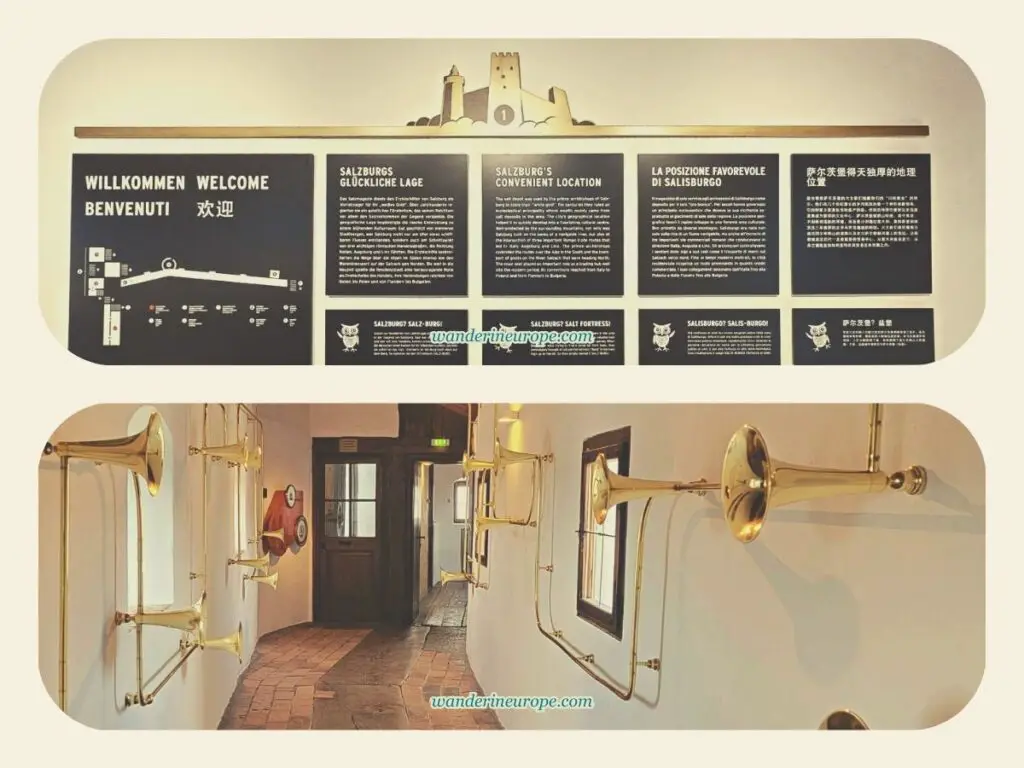



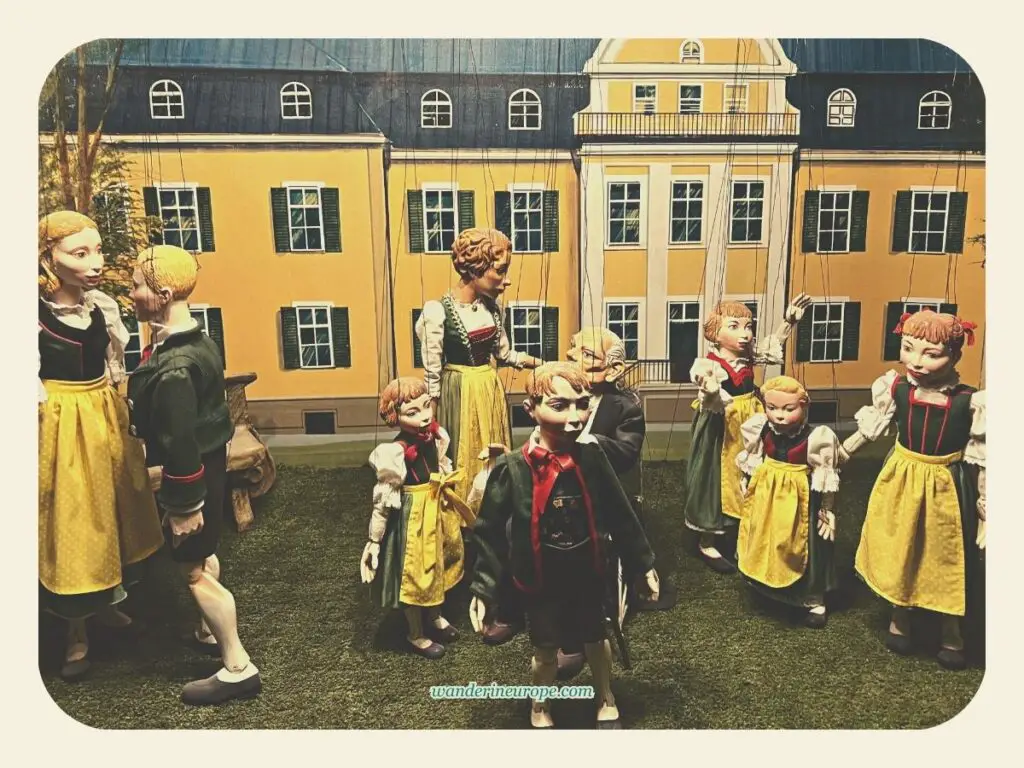



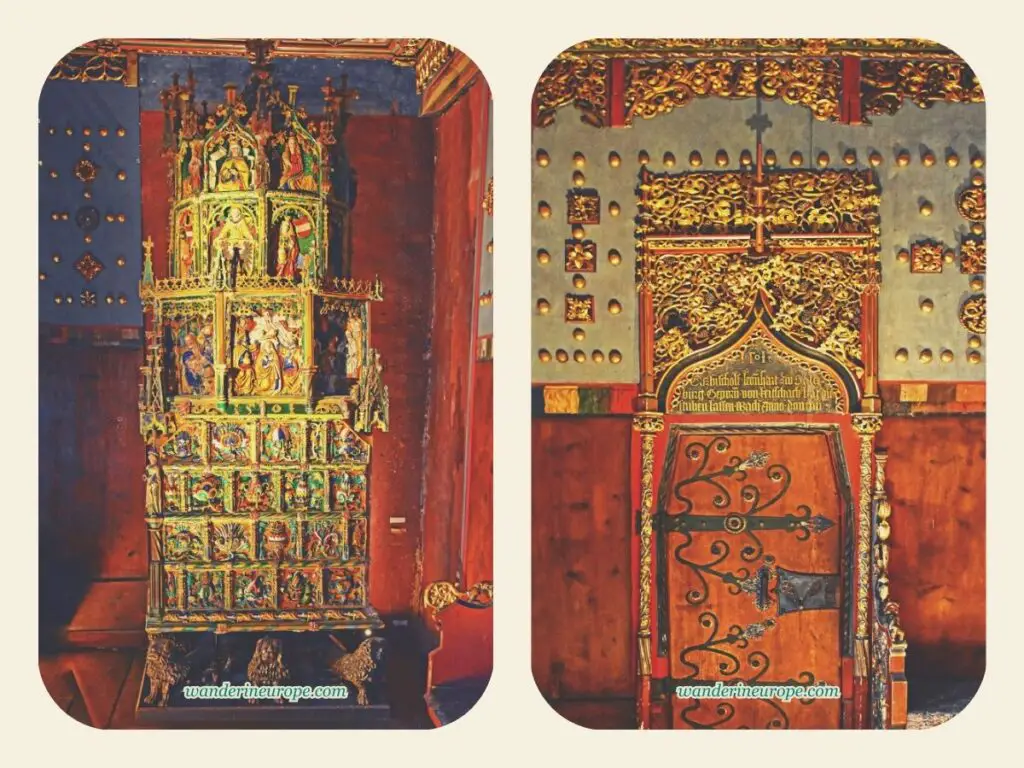


Learn more about Salzburg Cathedral: Complete Guide (with Facts and Visit Information)




Is Hohensalzburg Worth Visiting?
So, to wrap it all up, we can simply say…
If you’re visiting Salzburg, Hohensalzburg Fortress is an absolute must-include on your itinerary!
It’s the city’s main landmark and a real medieval gem. You’ll love the amazing architecture and the stunning views of the city it offers. Plus, there are museums to explore and music to enjoy.
Hohensalzburg Fortress is a fun history lesson, feast for the eyes, and a fantastic concert all rolled into one!
Especially, if you’re someone who enjoys wandering and discovering new things, like I do, then a visit to Hohensalzburg Fortress is sure to delight you.
Not to mention the panoramic views from Hohensalzburg’s viewpoints are truly something to behold.
While they may not be as breathtaking as those in Innsbruck or Lucerne and Interlaken in Switzerland, the experience of taking in the beautiful vistas from a history-rich fortress is truly unique.
And if you happen to visit when there are events taking place, your experience will be even more special!
From Castle Concerts to Music From the Trumpeter Tower, Jedermann in the Castle Courtyard, Romantic Christmas market, and more, they’ll surely make your Salzburg trip really a memorable one.
Be sure to check my resources for more information.
How Long To Spend In Hohensalzburg?
You’re visiting Hohensalzburg Fortress?! Well, I’m excited for you!
I know planning a trip can be overwhelming, especially when you want to make the most of your time.
If you’re still figuring out your Salzburg itinerary and wondering how much time to spend at the Hohensalzburg Fortress, I recommend setting aside 3-4 hours (half-day) with the all-inclusive ticket.
This is enough to fully explore the fortress, including the castle area, museums, and princely chambers at a relaxed pace.
But if you’re short on time, don’t worry! With the basic ticket, you can still see the castle area, take the panorama tour, and visit the museums in just 1-2 hours.
We’ll discuss the tickets next…
Visiting Information: Hohensalzburg Fortress
Opening Hours.
You can visit the fortress from 9:30 a.m. to 5:00 p.m. from January to April and October to December.
In May to September, it opens from 8:30 a.m. to 8:00 p.m., while the museums, princes’ chambers, and magic theater are open from 9:00 a.m. to 7:00 p.m.
On Advent weekends and Easter, the fortress opens from 9:30 a.m. to 6:00 p.m. On December 24th, it closes early at 2:00 p.m.
Important: Please check the official website of Hohensalzburg Fortress linked at the resources section for news and updates.
Arrival by Car.
If you’re driving, park your car at one of the public car parks in Mönchsberg or Nonntal, or other car parks such as Mirabellgarage, Rotkreuz-Parkplatz near the Salzach, or at the end of Linzergasse.
Since Salzburg’s old town is a pedestrian zone and not accessible by car, it’s time to stretch your legs and continue on foot from these parking options to Hohensalzburg Fortress.
Alternatively, you can park at the ‘Park & Ride’ parking spaces at the exhibition center or on Alpenstraße and hop on public transport to reach the old town.
Arrival by Train.
If you’re arriving by train:
- Take trolleybus (O-Bus) lines 1, 25, 3, 5 or 6 from Salzburg’s main railway station to the city center;
- Get off at Rathaus (Town Hall) or Ferdinand-Hanusch-Platz (Ferdinand-Hanusch Square); and
- Take a leisurely stroll along Getreidegasse and across Alter Markt Square, Residenzplatz, Domplatz and Kapitelplatz to reach Festungsgasse (Castle Street) in about five minutes.
Map of Hohensalzburg Fortress
Below is the map of Hohensalzburg Fortress and its labels to guide you during your visit.



Legend:
Tourist Areas:
- A — Panorama Tour
- B — Museums
- C — Princely Chambers & Magical Theater
- D — Armory
Castle Parts:
- 1 — Hohensalzburg Fortress
- 2 — Hasengraben Bastion
- 3 — Stables and Salt Depot
- 4 — Granary
- 5 — Cistern
- 6 — Armory
- 7 — Cable Hoist
- 8 — Kuenburg Bastion
- 9 — Keutschach Monument
- 10 — Hoher Stock
- 11 to 13 — Princely Chambers
- 14 — Old Fortress Funicular
Hohensalzburg Fortress Tickets
When you finally reach Festungsgasse, you are very close to Hohensalzburg Fortress.
It’s along this street that the last part of your journey to the fortress begins. You can choose to reach Hohensalzburg Fortress by funicular or on foot, depending on the tickets you purchase.
The entrance to Festungsbahn funicular — the more convenient way to reach Hohensalzburg Fortress — is found here in Festungsgasse.



There are four kinds of tickets to Hohensalzburg Fortress.
If you have the Basic Ticket with Fortress Railway or the All-Inclusive Ticket with Fortress Railway, you can take advantage of the roundtrip funicular ride included in the ticket package to reach Hohensalzburg Fortress quickly.
The funicular runs every 10 minutes and takes about a minute to reach the top.
The Basic Pathway Ticket and the All-Inclusive Pathway Ticket do not include the funicular ride up the hill to the Fortress.
If you purchase either of these tickets, you need to hike up the hill to reach Hohensalzburg Fortress.
Depending on how fast you walk, hiking can take 15 to 20 minutes.
While the path to Hohensalzburg Fortress is scenic, I still suggest buying tickets that include a roundtrip funicular ride. The 4-dollar upgrade is worth the convenience and time saved from hiking uphill.
You can check the current price of Hohensalzburg Fortress Tickets (with funicular roundtrip ride) here.
If you’re wondering what’s the difference between basic and all-inclusive tickets: basic tickets cover access to the Fortress Museum, Rainer Regiment Museum, Marionette Museum, Armoury, Panorama Tour, and courtyards, bastions, and chapel. Princely Chambers and Magic Theater are excluded.
On the other hand, you are allowed to explore all parts of the fortress if you have the all-inclusive tickets.
Get your Hohensalzburg Fortress Tickets here.
While you can enter Hohensalzburg Fortress with regular tickets, there are more ways you can spend time in the fortress and have a memorable experience. Below, I’ll let you know about more options.
However, if you’re visiting Salzburg during Christmas time, these experiences is a must:
Option 1 — Best of Mozart Fortress Concert and Dinner
Do you want to experience the best of Salzburg with a night of music, food, and fun at the Hohensalzburg Fortress? Consider this option.
It takes place in the evening, starting with a ride on the funicular railway. Then you’ll settle in for a concert of Mozart’s most famous works and hidden treasures, performed by world-class soloists.
After the concert, enjoy a romantic 3-course meal in the historic atmosphere of the fortress.
Learn more about the Best of Mozart Fortress Concert and Dinner here.
Alternatively, if you prefer to have dinner somewhere else, here’s what to check: Best of Mozart Fortress Concert (only).
Option 2 — Skip-the-line Hohensalzburg Fortress Tour
In this option, you will visit Hohensalzburg Fortress with an all-inclusive skip-the-line ticket.
You will be joined by a 5-star private guide for a tour of the castle and its rich history, architecture, and views.
There’s a 2-hour or 4-hour option, allowing you to explore the fortress and other Salzburg attractions.
Learn more about Skip-the-line Hohensalzburg Fortress Tour here.
Option 3 — Salzburg Cruise, Dinner & Fortress Concert
Imagine cruising along the River Salzach, taking in the stunning city skyline of Salzburg and the majestic Tennen and Hagen Mountains.
Then, treating yourself to a delicious dinner at the panorama restaurant of Hohensalzburg Fortress while enjoying breathtaking views.
And to top it all off, listening to the “Best of Mozart” concert within the splendid halls of the fortress, surrounded by its dreamlike flair.
This another way of experiencing Hohensalzburg Fortress is a fantastic option, right?
Learn more: Cruise, Dinner & Fortress Concert in Salzburg.
Sources: Hohensalzburg Fortress
That concludes my post about the magnificent Hohensalzburg Fortress.
I hope the information provided has been both informative and useful in planning your visit to this historic landmark. If you’re interested in learning more about the fortress, its history, and visiting information, please refer to the resources listed below.
These resources offer a wealth of information that will help you make the most of your visit to Hohensalzburg Fortress.
- Salzburg Museum official website (Fortress Museum)
- Rainer Regiment Museum official website
- Marionette Museum official website
- Events at Hohensalzburg Castle
- Official website of Hohensalzburg Castle
- All experiences in Salzburg with Hohensalzburg Castle
Discover more must-see destination in Salzburg!
- Unique destination — Hellbrunn Palace: 5 Things To Do (a Must Visit in Salzburg)
- Off the beaten path — Visiting Nonnberg Abbey in Salzburg: Tips and Information
- Charming village — Visiting St. Gilgen: 7 Things To Do In This Beautiful Village
- Breathtaking day trip — Berchtesgaden Day Trip From Salzburg: Must Things to Do

Save to Pinterest



